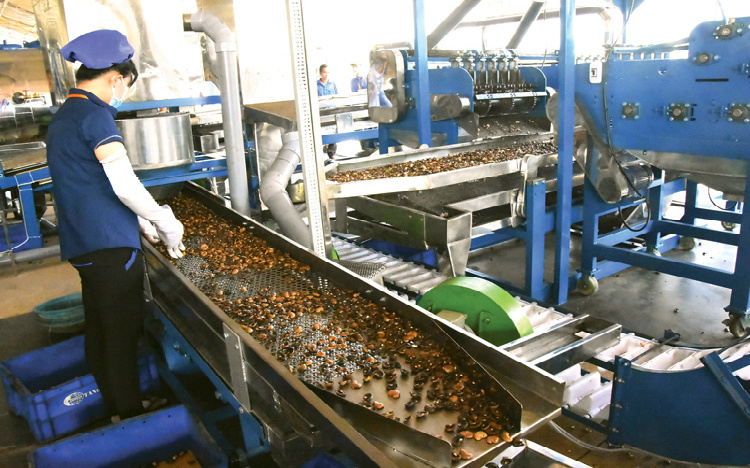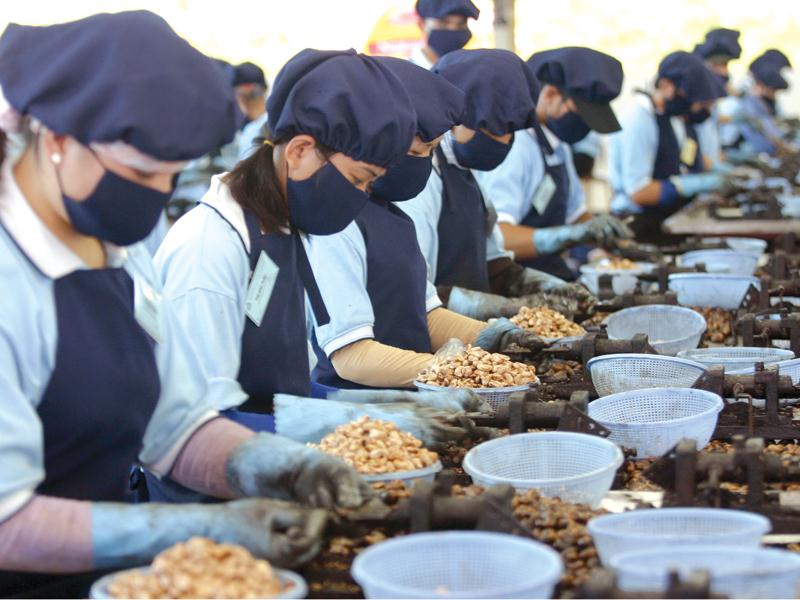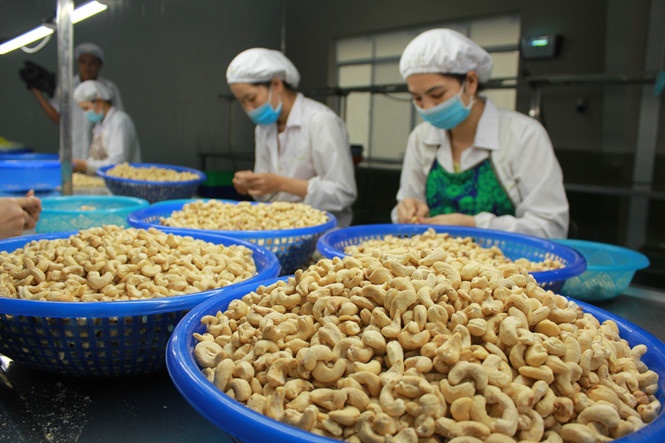The standard cashew nut processing process will make the product delicious and quality, save time and labor, thereby improving production quality, fully meeting the needs of consumers. Let’s learn with Wodagri a standard cashew production process.
-
Receiving input materials
Processed cashew nuts are delicious and qualified or not depends on the raw materials and cashew processing process, all shipments of raw materials when arriving at the factory must be checked before being imported. Raw materials after inspection, if they meet the quality (sensory perception) are transferred to preservation in the factory. In case the raw materials meet the requirements, they are allowed to be processed or stored. Such inspection will ensure that the raw materials entering the processing meet the prescribed requirements, preventing the use of materials that are likely to cause food insecurity. Conduct inspection in the order of principle: Reviewing the documents related to the shipment of raw materials, only allowing to receive the shipment when ensuring enough factors of origin and high safety. Inspect raw materials for color – smell – taste. Check the moisture content of the raw materials and the number of seeds / 1 kg must reach 180 seeds or less

-
Drying and preserving raw materials
Cashews are sun-dried on a clean cement base until the appropriate moisture content is <11%, then packed in bags and stored in separate batches in the warehouse, waiting to be put into production. Raw cashew nuts are kept in dry conditions, in order to avoid spoilage, superinfection with pathogenic microorganisms (bacteria, mold). General hygiene requirements: the drying yard must be clean of impurities (no waste), vehicles and storage warehouses must be hygienic – dry. In addition, during the storage period, fumigation will be carried out when there is a suspicion of insect development in the material.
-
Classification of ingredients (cashew size)
The standard cashew production process cannot ignore the stage of material classification, there is a certain significance in the preliminary screening of cashew nuts according to sizes A, B, C, D … for later cutting convenience, separate and remove impurities such as soil, rock, garbage… mixed in cashew. Once sized, cashews will be stored in bags and placed in batches.
-
Steaming
In order to make the cashew shell soft, to facilitate separation between the spongy shell and the silk shell, convenient for cutting. The process cycle is implemented as follows: Things need to be put into the heated steamer, the volume of each steaming is 1,600 kg – 2,500 kg, at a pressure of 0.7 kg/cm3 – 2.0 kg/cm2, time. Steamed for 20 to 50 minutes (depending on the ingredients), then the goods are taken to the conveyor belt to cool down, after cooling, they will be put into the trays.
-
Cutting apart
Requires workers participating in production to ensure hygiene and health requirements. The factory – production tools must also be absolutely hygienic. Cashew nuts are cut shell, kernel separated with a specialized knife, in order to improve the quality of the product and meet the requirements in the product forming process. Cutting and splitting requires a certain ingenuity and technique of workers. During this process, it is necessary to pay attention to the correct operation to avoid the case of cashews being peeled or broken – stabbed, the products need to be distinguished from each other through the supplier’s shipment (by date and time, sizing product number).

-
Drying and roasting cashew nut
Using a roasting machine to dry the cashew kernel helps to ripen the cashew kernel, creating conditions for the cashew husk to separate from the cashew kernel. This is the most important step to decide whether the finished product is qualified and delicious, not only saving costs and time but also killing pathogenic microorganisms through heating, meeting the requirements in the production process. Cashew kernels are put into drying in kilns, with a drying time of 11 ± 2 hours. After drying, the products are put into the boxes, then transferred to the stage of peeling husk by conveyor belt.
-
Husk peeling
After peeling, the cashew kernel product will have the shape of a crescent moon, with a beautiful opaque white color. To meet the requirements of product processing and improve the sensory properties of the product, the cashew kernels, after being dried, are peeled by the worker with a knife. Workers involved in the production of this stage must ensure hygiene and health. The factory and tools must also be hygienic. During the peeling process, try to avoid breakage and not break the cashew kernel, because it will damage the aesthetics and reduce the value of the product.
-
Sorting
To bring products to the same size – color, remove part of the impurities present in the product. Workers divide by color and check again according to grain size according to AFI standards, or according to customer’s request form.

-
Fumigating
Is meant to increase the shelf life of the product, kill and prevent the growth of insects in the product. Therefore, the product is fumigated with PH3 chemicals and is compliant absolutely according to SSOP reference, then the product is absolutely safe.
-
Sieving – packing – vacuuming
In order to preserve products well, increase sensory properties, limit the growth of pathogenic microorganisms, and limit insect penetration, products after fumigating should be packed into PE bags and vacuum sealed.
-
“Metal detector” stage
This is the stage of removing metals in products that are potentially dangerous to users. Accordingly, the product bags in each batch are put on the conveyor belt through the metal detector.
-
Packing – labeling
Will meet the requirements of customers, contribute to product preservation, limit the growth of pathogenic microorganisms, limit the penetration of insects and animals harm. Information on product boxes, before transferring to a specific product warehouse, includes: product name, net weight, gross weight, name and address of the manufacturer, product origin, product codes.
-
Storage
After packing, the product is stored in the finished product warehouse before being shipped. Finished products should be stored in appropriate conditions to maintain the product’s quality and limit the risk of contamination.
Above are the basic steps of a standard cashew production process. Hope it’s useful for you guys!


 中文 (中国)
中文 (中国)